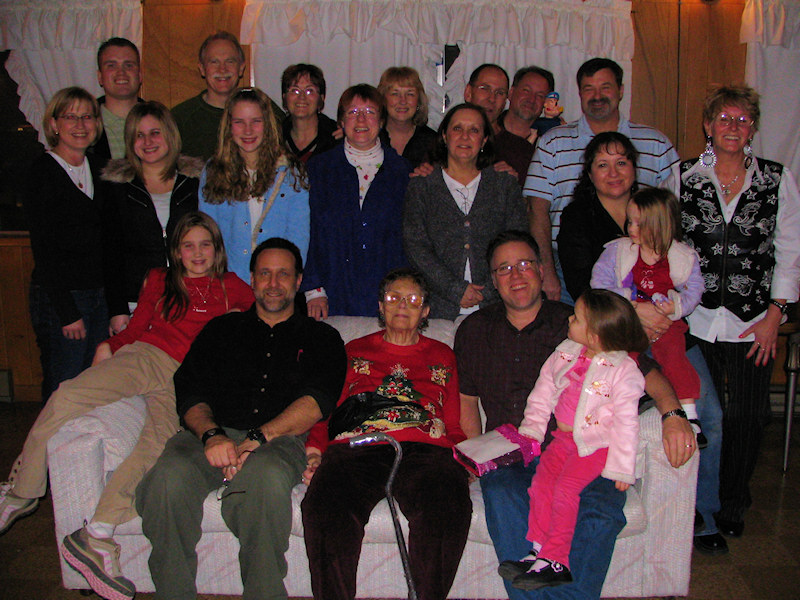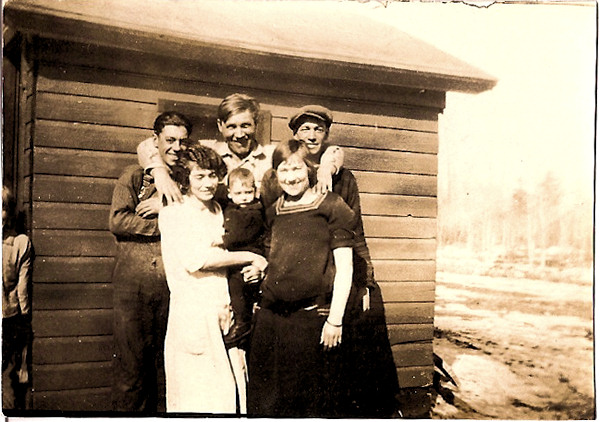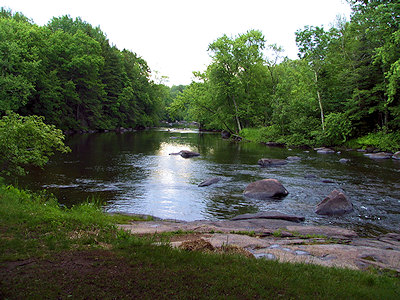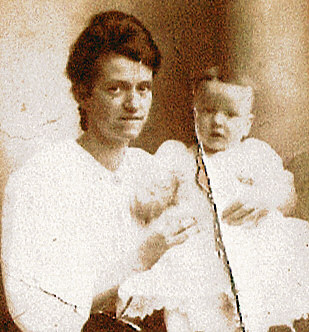As I dig into the more recent history of my family, Snohomish County and Everett, Washington, and the surrounding areas played a huge part not just in my life, education, and culture, but also to several branches of my family, especially the West and Knapp sides.
The West family came from Michigan to log the Pacific Northwest, surviving in rough logging camps at the turn of the century. A family of adventurers, they arrived on the Mayflower and brought “civilization” across what became the United States. While not leaving a huge impact on Snohomish County, my Grandfather Howard W. West guarded the Pacific Northwest waters at sea and inland his entire life, serving on the new USS Arizona 15 years before Pearl Harbor, raising his children in Marysville and later at the Friday Harbor lighthouse, and dying as security for Chief Joseph Dam.
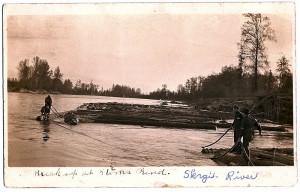 My mother’s Knapp family was forced by the Depression to leave behind their beloved but poverty and struggles in the logging community of Taylor Rapids, Wisconsin, for the west coast, seeking a better life. Knowing nothing but logging, they joined the logging camps in Oregon until a fire destroyed what little they had left. They moved to the wilderness of Snohomish County to work the Frye Lettuce Farm in Monroe, then the logging teams blazing roads roads through the forested mountain foothills to build what is now Old Highway 2.
My mother’s Knapp family was forced by the Depression to leave behind their beloved but poverty and struggles in the logging community of Taylor Rapids, Wisconsin, for the west coast, seeking a better life. Knowing nothing but logging, they joined the logging camps in Oregon until a fire destroyed what little they had left. They moved to the wilderness of Snohomish County to work the Frye Lettuce Farm in Monroe, then the logging teams blazing roads roads through the forested mountain foothills to build what is now Old Highway 2.
Two of the Knapp brothers married into the Elwell family, descendants of Chief Seattle. Robert Knapp stayed with his wife, Evelyn Elwell (of Charles Elwell and Laura Stillman), in Lake Stevens. Lloyd married Irene Elwell and moved to Eastern Washington. Wayne Knapp married into the Odell family of Snohomish, another family of early homesteaders, merging native Americans even further with immigrant whites.
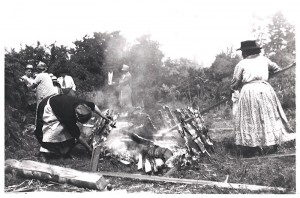 Father-in-law Captain Elwell hired on Robert and Wayne on the tug, Skagit Chief, maneuvering logs through the treacherous waterways of the Snohomish and Skagit Rivers and Puget Sound. As the roads opened up, cargo moved from the waterways, and the two Knapp brothers found jobs as security guards at the Monroe State Prison. Wayne soon moved onto Seattle, working his way up to the head of Boeing security.
Father-in-law Captain Elwell hired on Robert and Wayne on the tug, Skagit Chief, maneuvering logs through the treacherous waterways of the Snohomish and Skagit Rivers and Puget Sound. As the roads opened up, cargo moved from the waterways, and the two Knapp brothers found jobs as security guards at the Monroe State Prison. Wayne soon moved onto Seattle, working his way up to the head of Boeing security.
Snohomish County has a long history, going back to the Native Americans. Everett, Washington, played a role in both World Wars as a protected port for the Pacific ocean. Just recently, a World War I cannon was found in Clark Park in Everett on Lombard Avenue, though not lost in the sense of lost to history but missing from the park in a mystery over 10 years old. It was found in a maintenance area of the park, forgotten and ignored. The city is now trying to figure out how to restore and/or protect this one playground for myself and children to climb over and pretend we were fighting the enemy below on the bay.
Paine Field Airport was named for a pilot in World War I, and the Boeing plant in Mukilteo, southwest of Everett, continues to be one of the largest buildings on one floor in the world as well as a major driver to the world economy and transportation system. Port Gardner Bay, once filled with logs yanked down the foothills of Mt. Pilchuck and all over Snohomish County, still hosts the paper mill remains, part of what pulled Everett out of the Great Depression when logging ran dry. It’s now dwarfed by the new marina and naval base next door.
Everett was a cross road for transportation in all directions. From the sea to the mountains east across Highway 2, later complemented by the North Cascades Highway connecting the northwestern part of the area with Eastern Washington during the passable times of the year. To the north lie Vancouver, Canada, along Interstate 5, and to the south, along the same highway, lie the industrial city of Seattle and points beyond all the way to Mexico.
From the earliest years, Everett and Snohomish County played a crucial role in the lives of Native Americans as they were gathered together and relocated to the Tulalip Reservation, home not to the Tulalip Indians, but a point of land considered waste land by government officials along the muddy flats of Port Gardner Bay and Puget Sound. Today, it hosts one of the more popular Casinos and hotels in the state, bringing popular names in entertainment and non-stop gambling and bingo to all.
There is so much history to uncover in Everett and Snohomish County, for myself as well as my family. While Everett, Washington, has its own Wikipedia page, I recommend you take time to read Mill Town: A Social History of Everett, Washington, from Its Earliest Beginnings on the Shores of Puget Sound to the Tragic and I (Washington Papers) by Norman H. Clark to learn more about this amazing region and its history.
Google has a fascinating search history timeline of Everett, Washington. It’s a bit misleading at there is an Everett, Massachusetts, and many people named Everett as a first and last name, and many references to George Washington, for whom the state was named, and an Edward Everett of Washington DC and George Washington history, so results going back to 1760 relate to published articles about those unrelated topics. However, there are some historical gems in the references published on the web covering the Bellingham riots of 1907 which later migrated to the Everett Jail, the Everett Massacre (a labor dispute that turned deadly in 1916), the courthouse fire of 1909, company announcements and news, property sales and development, many obituaries, biographies, government documents, and more.
One treasure I uncovered through the Google timeline search was an announcement in the Great Lakes & Seaway Shipping News Archive for September 2007:
On Saturday, 19 September 1891, at 11:00 a.m., the whaleback steamer CHARLES W WETMORE left Philadelphia, Pennsylvania loaded with the materials to build a nail mill, iron smelter and shipyard for the new city of Everett, Washington. Her skipper was Captain Joseph B. Hastings and she had a crew of 22.
One of the main streets in Everett, along which my great, great grandfather, Perry West, lived, is Wetmore. I didn’t know that a steamer ship had been named for the man, and how that name made it way into the history of Everett.
Here is a reference list of some of the historical sites I’ve found online that help tell the story and history of the area.
- American Indians of the Pacific Northwest
- Early Washington Maps
- Northern Pacific Trains in Everett, Washington
- Search pnwtest
- The Great Depression in Washington State
- Everett, Washington – Wikipedia, the free encyclopedia
- Primary Sources: PNW – History: United States – Subject and Class Guides at University of Washington Libraries
- Paine Field Tour – a knol by Andrew Czernek
- Journals of the Lewis and Clark Expedition
- Monroe Historical Society Museum, Monroe, Washington
- Seattle Times Northwest Source – Washington State Centennial Index
- Washington History Day Topic Guide – Washington History Day Topic Guide
- Everett Massacre – Washington History Day Topic Guide
- Weather History for Everett, Washington
- World War I Draft Registration Cards: Washington
- Illustrated History of the Everett Brewing Co. of Everett, WA
- Snohomish County History Series – The Seattle Everett Interurban Railway 1910-1939 (pdf)
- USS Snohomish County – LST 1126 – History of the Tank Landing Ship served in three wars (PDF)
- A Brief History of Snohomish County, Washington, by David Cameraon – League of Snohomish County Heritage Organizations
- Washington Digital Archives – Title Info for : Veterans’ Affairs, Department of, World War I Service Statement Cards, 1917-1919
- Everett Public Library
- Everett Public Library – Evergreen Cemetery images and history
- Everett Massacre Collection
- Family Photos of Snohomish County
- Everett Public Library – Snohomish County Women’s Legacy Project
- Everett Public Library – Oral History Collection
- Places of the Past: Everett & Snohomish County Historic Sites Online
- Everett Public Library – Digital Records
- Everett Public Library – Everett History
- Everett Public Library – Evergreen Cemetery Podcast
- History of the Rotary Club of Everett Washington
- History of U.S. 2: Houlton, Maine, to Everett, Washington – Highway History – FHWA
- Granite Falls Historical Museum
- Welcome to the Edmonds Historical Museum
- Historic Everett 2011 – tours, programs, & resources
- HistoryLink.org- the Free Online Encyclopedia of Washington State History
- Everett, Washington History and Trivia
- Pacific Northwest History
- Mukilteo Historical Society – Mukilteo, Washington
- The Museum of Flight Aviation History, Airplane and Spacecraft Collections, Aerospace Library, Education and Research Center | The Museum of Flight
- Paine Field Airport, Everett, Washington
- Skagit River Historical Timeline
- 2011 Skagit River Journal home: Sedro-Woolley-Skagit River and County & NW Washington
- Joe DeBay, Sterling settler on the Skagit River
- Albert E. Holland, pioneer Sedro druggist on Skagit River
- Snohomish County, WA – Family History Centers
- Stanwood Area Historical Society, Stanwood, WA
- Snohomish County Heritage » League of Snohomish County Heritage Organizations, Washington State Snohomish County Heritage
- Snohomish Historical Society
- Washington Secretary of State – Washington History
- Washington Secretary of State – Washington History: Historical Newspapers in Washington
- StillyMuseum of Stillaguamish
- Center for the Study of the Pacific Northwest
- Western Waters Digital Library: Home
- Snohomish County : Historic/Cultural
- History of Providence Hospital in Everett, Washington
Most Recent Articles by Lorelle VanFossen
- The Myths and Mysteries and Hunt for Nicholas Knapp
- The Perpetual Calendar
- GenSmarts: Reminder to Not Assume
- Gensmarts Saves Your Family History Research Life
- Digging Through Historical Newspapers Online

